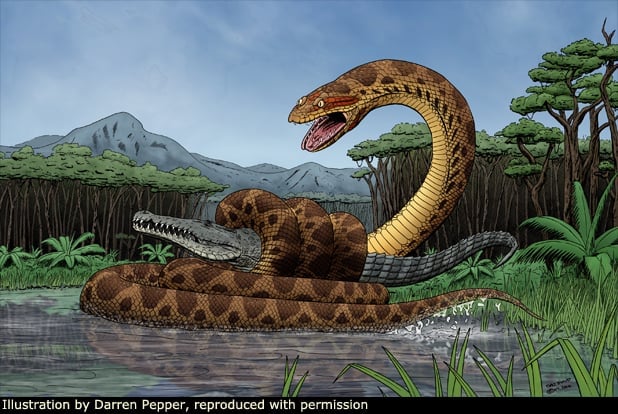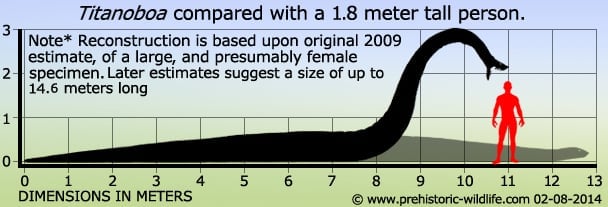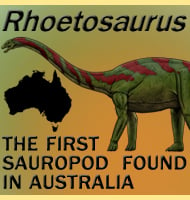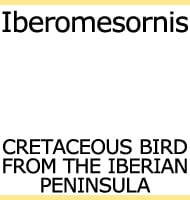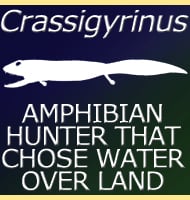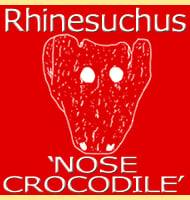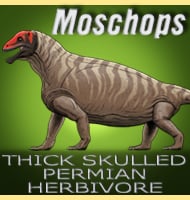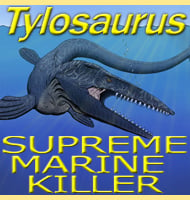Interactive Titanoboa Fossil Map & Timeline Chart
Discover Titanoboa with our interactive fossil map and geographical timeline chart.
The fossil map pinpoints discovery sites worldwide, click each marker to see fossil ages and detailed references..
The interactive bar chart reveals how many Titanoboa fossils were found across different geological ages, helping you visualize its prehistoric history and global distribution.
How big was Titanoboa and why did it grow so large?
When initially described in 2009, Titanoboa was estimated to have been about 12.8 meters long.
This meant that in at least terms of length, Titanoboa was larger than the previous record holder for largest ever snake, Gigantophis, by a comfortable margin. Later modelling shown as part of the Smithsonian documentary Titanoboa: Monster Snake suggested a total length of about 14.6 meters, a figure that has since been commonly rounded off to 15 meters by others.
Reptiles are commonly thought to grow in accordance with the available ambient temperature of a climate. This is because higher temperatures that remain fairly constant throughout the year with very little seasonal variation allow ectothermic (cold blooded) animals to maintain an optimum metabolism for longer.
This means that bodily functions such as digestion, circulation and respiration among others all become far more efficient, and a greater amount of energy can be set aside for other areas such as growth.
In reference to the larger size of Titanoboa, this could indicate that sixty million years ago global temperatures, specifically at the equator but quite possibly further away, were considerably higher than those we know today. This is because today the largest known snakes which live close to the equator can commonly attain sizes of five to six meters in length, with rarer individuals approaching six and a half to seven meters long.
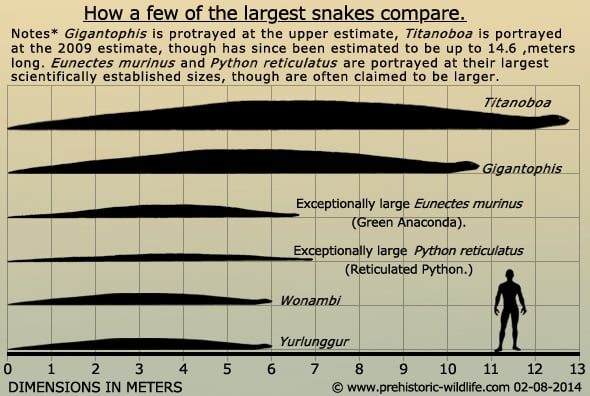
Titanoboa. is usually credited as being around thirteen to fifteen meters long, though it must be appreciated that as a genus, very little fossil remains of Titanoboa are known to us at the time of writing.
It is not inconceivable that Titanoboa may have still grown even larger, but caution should be exercised in this as reconstructions should always be based upon existing fossil material. In comparison to modern snakes that are alive today, the largest snake by body weight is the Green Anaconda (Eunectes murinus), which is credited as attaining a length of just over six and a half meters long.
The largest snake by body length however is the Reticulated Python (Python reticulatus) with is credited as approaching seven meters long for the largest individuals.
On an additional note about the Green Anaconda and Reticulated Python, both snakes are commonly cited as being larger than these figures, but by how much can vary greatly by source, with ten different sources giving you ten different estimates.
There have also been many eye witness claims, especially dating back to the eighteenth and nineteenth centuries of far larger anacondas and pythons that would have been bigger than Titanoboa. There is however no proof of these monster snakes, and even many more modern estimates have since been proven to be invalid.
A problem is that most large snakes reported to science are usually dead, and when being preserved snake skin can stretch by a surprising degree, with the skin from a five meter long snake feasibly being capable of being stretched out to seven and a half meters, giving the false impression to later viewers that a snake was half as big again than it actually was.
This is why only measurements of live snakes taken by those who are experienced in handling and measuring snakes are paid any attention by the scientific community.
Before moving on to the next segment, a special consideration regarding size in Titanoboa is gender. There is an observable pattern amongst snakes in that females usually grow larger than males. Although remains of Titanoboa are still too few to conclusively illustrate a difference between male and female Titanoboa, it would actually be unusual if female Titanoboa were not larger than males.
When and where did Titanoboa live?
Titanoboa fossils are so far only known from the Cerrej�n Formation of Colombia in South America. The Cerrej�n Formation represents what is at the time of writing the earliest known occurrence of Neotropical rainforests (rainforests of Central and South America).
The area of the Cerrej�n Formation that the Titanoboa holotype fossils are known from has been established as going back to the Selandian of the Paleocene.
This means that Titanoboa are known to have lived about sixty million years ago (give or a take a million years), and approximately five million years after the KT extinction which marks the end of the Mesozoic and the disappearance of the dinosaurs. During this time, Titanoboa would have lived and hunted in low lying rainforests that contained an extensive system of rivers that criss-crossed over the landscape.
How did Titanoboa kill?
Snakes are usually what you would term generalists that will eat whatever they can catch. This is especially true for constrictors that do not rely upon venom to subdue prey, and therefore have no reliance upon venom working which may have different effects upon different types of animals.
By constricting however, the method of killing is asphyxiation from the prey having its lungs squeezed by the muscular coils of a snake so that the lungs cannot expand to take in fresh oxygenated air.
Whereas constrictors do not have fangs for injecting venom, they still have rows of teeth that grow in rows within the upper and lower jaws. These teeth are usually very thin but pointed sharp like needles, and are adapted for puncturing soft tissues and holding prey in place.
A specific adaptation to this purpose is that these teeth are usually strongly recurved. What this means is that the teeth bend like curved hooks so that the points of the teeth actually project to the rear of the mouth and the opening of the throat. Because of the shape, when these teeth hook into the flesh of a prey animal, there is no way for that animal to pull itself free.
For example, if a constrictor like an anaconda or a python ever latched on to something like your hand, the worst thing that you could do is to immediately try to pull it out because you would only drive the snakes teeth deeper into your own flesh. What you would instead have to do is to first push your hand deeper into the snake’s mouth, and then open the jaws before you were able to pull your hand free.
Though only partial skull and jaw bones have been found, Titanoboa would still be expected to have had rows of recurved teeth within the mouth. In the first instance the teeth would have been used to dig into the flesh of a prey animal.
This in turn would enable the head to gain a secure hold onto the prey so that no matter how hard the prey struggled, there was no way for the prey to pull itself free by brute force. With a hold secure, the Titanoboa could then coil its immense body around the body of the prey and then just squeeze. With a body made mostly of muscle, even a moderately sized Titanoboa would have been capable of inflicting severe pressures against the body and most importantly the lungs of its prey with very little effort on its own part.
Making an actual kill could actually have only taken a matter of minutes for a Titanoboa, but the actual eating of the prey would have been considerably longer. The known skull and jaw remains of Titanoboa show that it would have had a similar head construction to other constrictor snakes like anacondas.
This means that the lower jaws would have extended past the back of the skull to allow for an even greater range of movement for opening the mouth. In addition to that the lower jaws would have not only been unfused at the front, they were also capable of independent movement to one another.
This means not only could the lower jaws come apart for an even greater opening, but the snake could have moved up one jaw, then the other, in a fashion that would allow the mouth to ‘walk’ over the body of its prey. Again the recurved teeth would have been of benefit again, because one side could anchor the head in position while the other part moved along, and vice-versa.
Once the body of the prey was within the stomach of the Titanoboa, stomach acids would have dissolved all parts of the animal from soft flesh, to hard bone. How long it takes to digest an animal will of course depend upon the size of the prey, with bigger animals that have more mass taken longer (there’s just more to dissolve). Metabolism is also a factor, and the closer a snake comes to its; optimum temperature, the more efficient the digestion process.
In terms of actual hunting behaviour, the sheer size of a large Titanoboa would mean that it would have been incapable of moving through the tree canopy like many smaller forms, and so Titanoboa probably spent their time slithering around trees than trying to climb them.
The large size of a Titanoboa body, particularly the associated weight, would also mean that a Titanoboa would have been physically cumbersome when moving over the land. However, when lurking within the undergrowth, a Titanoboa would have still been capable of initiating a lightning fast ambush strike at a passing prey animal while hidden within the undergrowth.
Titanoboa would have been at their most dangerous when in the water. When in the water, body weight means very little since the buoyancy of the water would counteract the effects of gravity upon the body (this is exactly why marine animals like whales grow so big).
This would mean that even a large Titanoboa would have been very quick when moving through the water as well as expending comparatively little energy to do so than what it would have had to do if on land. Another advantage of hunting in the water is that the sheer bulk of the body of Titanoboa would have been hidden by the water.
When striking animals that were on or near the surface, the surface sheen of the water would have hidden any approach from a Titanoboa submerged under the surface, while the Titanoboa would have been able to lock on to the silhouette of its targeted prey.
In addition Titanoboa would have been capable of lurking upon the bottom of water system and holding its breath for a considerable time, waiting for other animals swimming through the water which it could then strike at from below.
What did Titanoboa eat?
As stated above, snakes tend to be generalists, even those species which may display a preference for certain types of animals through specific patterns of hunting behaviour, will attempt strikes on other animals if they think they have an opportunity for a meal.
In determining what Titanoboa ate, we have to look to the other known fauna of the Cerrej�n Formation. Some animals that immediately stand out are crocodiles, specifically the genera Cerrejonisuchus, Acherontisuchus and Anthracosuchus.
Although crocodiles are fearsome predators in their own right, it is a known scientific fact that they can become prey to large snakes that will think nothing of attacking and consuming them. This behaviour has been independently witnessed, photographed and videod in modern snakes like anacondas, and by extension it seems perfectly plausible that a snake such as Titanoboa, known to be much bigger than modern snakes, could have been attacking and eating crocodiles, some of which were comparable in size to modern forms.
Prehistoric crocodiles and giant snakes were not the only reptiles present in the Cerrej�n Formation, large freshwater turtles much bigger than those we know today were also living there during the Paleocene.
These genera include Carbonemys and Puentemys, and both of these turtles are known to have grown so large that it is perhaps highly unlikely that even a Titanoboa could have swallowed them whole. This might in fact be part of the reason why these turtles grew such large shells in the first place, with them being so big, they may have effectively taken themselves off the menu.
It could be argued that a large Titanoboa could have crushed a turtle shell within its coils and broken it up, but this would have taken substantially more effort than just squeezing air out of the lungs, and while snakes are capable of digesting bone and shell, it takes far longer to digest than more ‘fleshy’ prey such as crocodiles. Therefore while it might have been possible for Titanoboa to hunt turtles, particularly smaller juveniles, they may have had a preference towards ‘easier’ prey.
A third prospect for Titanoboa prey that still takes people by surprise is large fish. Fish are known to be eaten by snakes, including constrictors like anacondas, and the remains of particularly large lungfish that may have grown to as much as three meters long are known from the Cerrej�n Formation. A Titanoboa would have certainly been capable of striking at a large fish, but killing a lungfish may have been a little more problematic.
As long as water passes over the gills you can’t drown a fish like you could a crocodile, and you can’t suffocate a lungfish just by removing it from the water. What makes a lungfish a lungfish is its ability to breath out of water.
A Titanoboa could have still killed a lungfish by constriction, such as by closing gill openings under the water, or dragging the lungfish out of the water and then squeezing, but if Titanoboa also ate these large lungfish, then they may have begun swallowing the fish while still alive, and then relied upon that process to asphyxiate the fish. A Titanoboa may have been able to hold onto a lungfish for some time as long as the glottis, the opening in the lower mouth was not obstructed so that the Titanoboa itself could still breathe.
Another subject to cover is of course cannibalism. Snakes in the wild are known to eat other snakes, including those of their own species if they spot an individual that is particularly smaller than themselves.
If Titanoboa were like other constrictors, then females would have been substantially larger than males, so much so that a male would have been an easy meal for a large female. Female upon male predation has been recorded in modern anacondas.
The above is speculation based upon the known fauna of the Cerrej�n Formation. It is quite probable that other types of animals such as birds and mammals were also present in the same environment and that we simply have not found any fossils for these yet.
It is worth noting that not every animal gets fossilised, and in the case of the Cerrej�n Formation being a working coal mine, it is almost certain that an uncountable number of fossils unknown to us have already been destroyed.
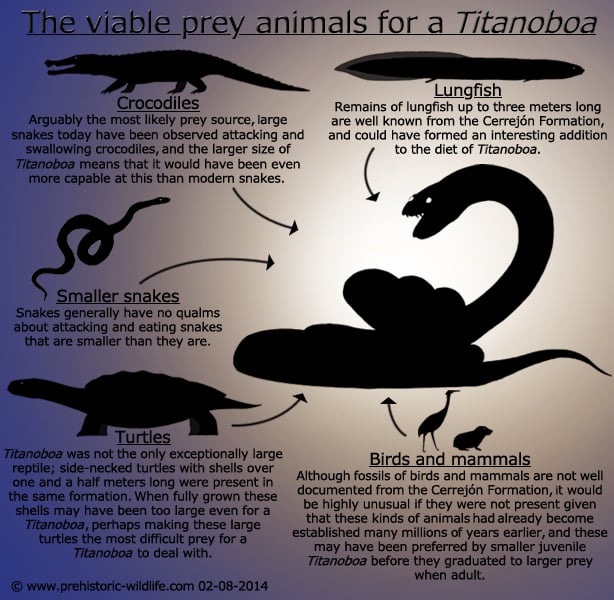
Why did Titanoboa go extinct?
In simple terms no one knows for sure, but there are two main theories. The first is global temperature change. Today we can establish a clear correlation between reptile size and ambient climate temperature. The hotter the climate the larger reptiles seem to get.
Those in temperate locations and/or with a strong seasonal variance between hot and cold seem to stay fairly small. However as you get nearer the equator, average temperatures rise and seasonal variation is near non-existent due to the simple fact that daylight exposure to the sun is at a constant.
By contrast extreme north or south latitudes experience extended or reduced daylight hours depending upon how the Earth tilts on its rotation as it orbits the sun on its yearly cycle.
Because temperatures nearer the equator are more constant, it is easier for reptiles to exploit that ambient temperature. The ambient temperature is also near optimum for reptiles, so that their metabolism is operating as it should, something which many researchers believe allows reptiles living closer to the equator to attain large sizes because they do not have to be concerned with a high variance in local temperatures.
Titanoboa being so large has been taken as an indication that the planet had a higher average global temperature during the Paleocene than previously thought. It is also thought however that average global temperatures were very slowly declining something that is thought to have contributed towards a global shift from dense forests to open grasslands during later epochs going on towards the Miocene.
One idea is that Titanoboa may eventually have not been able to maintain their metabolisms due to falling temperatures in their ecosystems, something which may have seen them replaced by smaller snakes that could still operate optimally in the lower temperatures.
Other giant snakes such as Madstoia and Gigantophis in other parts of the world are known to have been around until the mid-Eocene period roughly some twenty million years after the disappearance of Titanoboa.
The presence of these snakes later in the fossil record proves that giant snakes did not vanish overnight, yet since the fossil evidence at the time of writing indicates that these snakes were smaller than Titanoboa, then they may actually support the theory of steadily declining global temperatures driving a shift into the dominance of smaller snake forms.
The other theory that explains the extinction of Titanoboa is of course habitat change. Around sixty million years ago the Cerrej�n Formation was low lying coastal plain, covered with lush rainforests that had an extensive system of numerous rivers running across the landscape.
In stark contrast to this ancient depiction, the Cerrej�n Formation is today (at the time of writing) the largest coal mine in Colombia, and is situated much higher above sea level than it was during the Paleocene.
The coal of the Cerrej�n Formation is essentially the fossils remains of all the plants and trees that once formed the lush rainforests that would have been present in the time of Titanoboa. This has preserved numerous fossils of plants, as well as many animals, but it also proves that the specific habitat that Titanoboa lived in is now gone.
However, it is of course plausible that Titanoboa may have had a wider geographic and temporal distribution than what we know about, we just don’t know about the fossils yet.
Suggested viewing
- – Titanoboa: Monster Snake – Smithsonian – 2012.
Further Reading
- - Giant boid snake from the Palaeocene neotropics reveals hotter past equatorial temperatures. - Nature 457 (7230): 715–717. - J. J. Head, J. I. Bloch, A. K. Hastings, J. R. Bouorque, E. A. Cadena, F. A. Herrera, P. D. Polly & C. A. Jaramillo - 2009.
